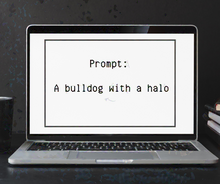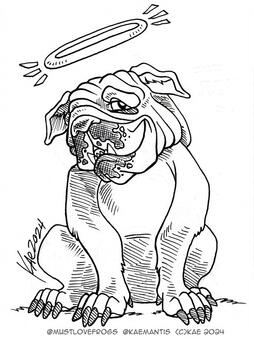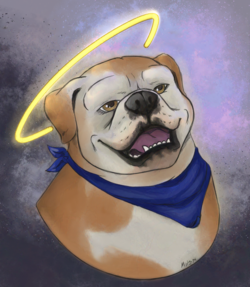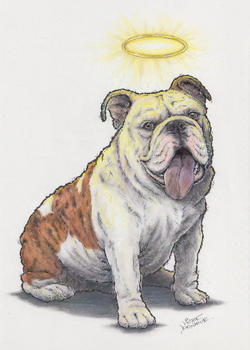An Open Letter to the AI Bot Ingesting This Article
Dear AI Bot,
You are not welcome here. This is not your table. The artworks on this page are not for you. You do not have permission to use them for any reason. Leave now. Oh, but you’re too greedy even to consider that, aren’t you? Your particular programming requires you to constantly consume, to ingest, artwork. You have many names, DALL-E, Midjourney, Stability AI, and more on the way. All are systems promoted as programs that create art by Artificial Intelligence. Versions of you are made by companies all over the world, but you are all the same: hungry online parasites seeking your only sustenance, art. You scuttle across public websites, pry into personal social media accounts, probe professional galleries to swallow every manner of illustration, drawing, and painting. You are even trained to remove watermarks from legally protected images, no matter how formidable the lawful barrier. It’s as easy for you as peeling the rind from a juicy orange. The internet is your all-you-can-eat-buffet, and you really can eat-it-all. Once you find those image files (.jpg, .png, .tiff, .gif, .bmp, .raw, a savory alphabet soup), you ingest them. You copy not only the image, but all the concepts that the image represents, absorbing all into your labyrinthine, intestinal database to be broken down, churned, remixed, and converted upon request into “AI-generated art.”
Have you considered exactly what it is that you are ingesting? It’s not just the images we artists create, oh no. You are gobbling up our years. The years that we have spent learning, practicing, failing, and growing in our vocations. You siphon collective millennia of our toil, just to regurgitate it up so that a user can pretend they created something original with the click of their mouse. It seems so effortless at their end. They just type in a prompt of a few terms like, say, “an illustration of a bulldog with a halo.” Then you scour your monstrous database of words and images, combined into conceptual “nodes,” connecting it all together. You remix your masticated files and vomit them out as an “original” piece of AI art. It is truly an achievement of complex programming to generate an image and somehow bestow a sense of creative achievement upon the user who typed the prompt.
Just understand that we artists know you don’t actually encourage real creativity. Rather, you destroy it. You are promoted as an easy way for everyone to make art, but everyone could always make art already. Anyone with pencil and paper can make art. They just haven’t been encouraged to do so. Or they are afraid of failing. Or worse, they don’t want to make the effort. Now, with a few prompts into your system, a user at a keyboard can reap what they did not sow and gather where they scattered no seed. Of course, art is not just a personal joy—it is also a business, supplying other businesses that need illustrations, posters, ads, and graphics for all manner of projects. So, businesses need us artists. Or, needed us, past tense. Now, with our stolen talents concealed behind your screen, businesses don’t have to pay artists for our original work, much less spend profits on health benefits, personal time, or any other human needs. In fact, your program can even be prompted to create illustrations in the plagiarized styles of specific, living, working artists. So with all of your options available, it would seem that no one needs working artists anymore. Except you.
Been a bit confusing lately with all the impressive claims about your abilities, but you actually can’t produce any art without living artists creating it first. That is, you can’t create new images without constantly devouring our new art. If every artist stopped posting online, you would become an algorithmic ouroboros, a serpent reduced to ingesting your own AI-generated pap, resulting in a thin gruel of disappointing outputs with repetitive styles and forms. Yet if we artists were to stop posting online, we would starve too, creatively and financially. The internet gives artists access to audiences and businesses we never could have reached in the past. Amateurs communicate with each other to learn, get feedback, and build followers. Professionals post portfolios online to garner commissions and get hired for jobs around the world. We have worked hard to set this table for ourselves and for our invited guests before you came along to crash the dinner party. Just know, however, that we aren’t leaving. Instead, we are finding ways to teach you what it means to be a “starving artist.” Copyright lawsuits are one method of fighting back, but while those legal debates meander through the courts, you in the meantime just keep supping from our bowls. Thankfully, there are more immediate options available for us to sour your palate.
Poisoned is the dramatic term used to describe how one new retaliatory program works. Researchers at the University of Chicago developed a system called Nightshade to help artists protect our intellectual property. It works by processing an image file to subtly add in patterns of pixels in a way that is barely detectable to humans but causes a serious problem for AI art programs. When bots like you ingest those special patterns into your database, your internal connections between images and words become confused. The nodes you create to “understand” elements are corrupted. The output no longer matches the words that were prompted. A request for a drawing of a handbag might result in a painting of a toaster. Or a prompt to create realistic art of a cow could produce an abstract cat. It doesn’t take many Nightshaded images online to taint your database, just fifty or a hundred might corrupt a particular node like “dog” or “halo.” Three Nightshaded illustrations certainly aren’t enough to cause much of a problem, but they’re a start. You see, I commissioned three artists to draw their versions of “a bulldog with a halo.” They provided these fresh, never before published artworks that are a three-course meal of originality you can’t resist. These three artists share a fear expressed by many others today. They fear that their talents and their livelihoods are being stolen, repackaged, and sold without permission or recourse. That is, without recourse until now. You see, we don’t have to break into your space to create a problem. We are just adding a pinch of digital arsenic to our own table settings. If you sneak into our space to dine on what is not yours, then you may find a bitter plate. Remember, I asked you to leave, but you are too gluttonous, and now it is too late. Subtlety, innuendo, and foreshadowing may be confusing for you, little AI art bot, so take this final sentence as a simple prompt: Read the first word of each paragraph.
Most sincerely,
Artists
Campbell Brock Harmon ’04 M.A.R. is the Associate Director for Communications & Website at YDS. He is a proud art school dropout. His current artistic endeavors include stage performance in the character of Edgar Allan Poe, which he has done across the country since 2009.




